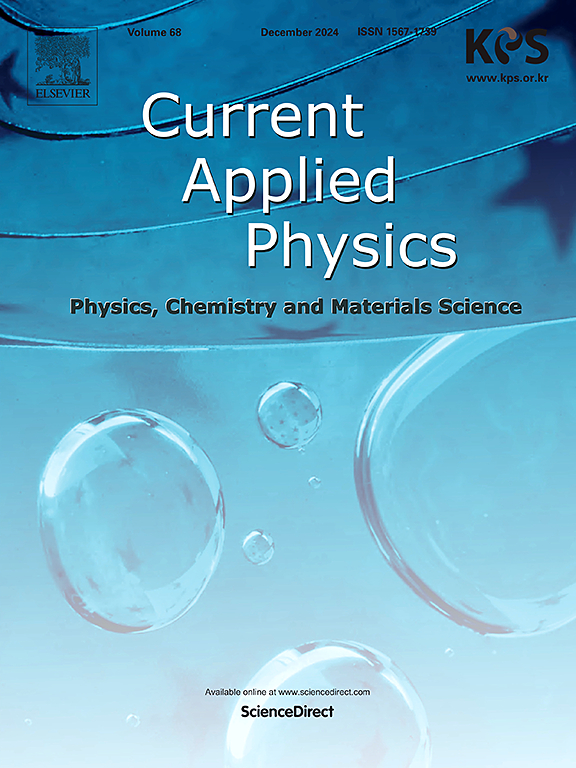探索VO2薄膜的相变动力学:衬底温度的作用
IF 3.1
4区 物理与天体物理
Q3 MATERIALS SCIENCE, MULTIDISCIPLINARY
引用次数: 0
摘要
我们研究了衬底温度(TS)对六方ALO(0001)和立方YSZ(001)衬底在~ 500°C - 800°C氩气环境下沉积的RF溅射VO2薄膜相变特性的影响,以及与结构和形貌的关系。高分辨率x射线衍射(HRXRD)和拉曼光谱证实了多晶VO2 (M1)相的形成,并伴有微量的二次相。原子力显微镜(AFM)和场发射电子显微镜(FESEM)显示出不同的表面粗糙度和晶粒形貌。c面蓝宝石(ALO)表面粗糙度显著增加,晶粒大且不均匀,而钇稳定氧化锆(YSZ)表面粗糙度小且均匀,随温度升高表面粗糙度变化最小。在600°C以上,两种衬底上的VO2薄膜表现出可逆的绝缘体-金属转变(IMT/MIT),具有~(3-4)阶电阻率变化和明显的热滞后,接近~ 340K。转变温度(TC)在~ 700℃时降到最低,然后又随着温度的升高而升高。随着温度的升高,滞回宽度在ALO (~ 1K ~ ~ 10K)上增加,而在YSZ (~ 14K ~ ~ 7K)上减小。在高于~ 600°C的两种衬底上,薄膜的室温平均温度电阻系数(TCR)为~ (1.61 - 3.18% K−1),升温峰TCR在ALO上为~ (54.30 - 85.39% K−1),在YSZ上为~ (85.31 - 98.02% K−1)。在金属相和绝缘相中观察到明显的活化能依赖于衬底类型和温度。观察到的VO2薄膜的相变特征是基于不同结构和形态的变化,这在很大程度上取决于衬底类型和温度。这些发现预示着衬底类型和温度在调整VO2薄膜的结构和相变特性方面起着决定性的作用。本文章由计算机程序翻译,如有差异,请以英文原文为准。

Exploring phase transition dynamics in VO2 films: The role of substrate temperature
We investigated the effect of substrate temperature (TS) on the phase transition characteristics of RF sputtered VO2 films deposited on hexagonal ALO (0001) and cubic YSZ (001) substrates at ∼500°C–800 °C under Ar ambient only, in correlation with structure and morphology. High-Resolution X-ray Diffraction (HRXRD) and Raman spectroscopy confirmed the formation of the polycrystalline VO2 (M1) phase with traces of secondary phases. Atomic Force Microscopy (AFM) and Field Emission Electron Microscopy (FESEM) reveal distinct surface roughness and grain morphology. Surface roughness increases significantly with large and non-uniform grains on c-plane Sapphire (ALO), whereas on Yttria-stabilized zirconia (YSZ), grains are small and uniform, having minimal surface roughness variation with increasing temperature. Above 600 °C, VO2 films on both substrates exhibit reversible insulator-metal transitions (IMT/MIT) with ∼ (3–4) order resistivity change and pronounced thermal hysteresis close to ∼340K. The transition temperature (TC) decreases with minima at ∼700 °C and again increases with temperature. Hysteresis width increases on ALO (∼1K–∼10K), whereas it decreases on YSZ (∼14K–∼7K) with increasing temperature. Films on both substrates above ∼600 °C exhibit room temperature average Temperature Coefficient of Resistance (TCR) of ∼ (1.61–3.18 %K−1) and warming peak TCR of ∼(54.30–85.39 %K−1 on ALO) and ∼(85.31–98.02 %K−1 on YSZ). Distinct Activation Energy (EA) dependence on substrate type and temperature has been observed in metallic and insulating phases. The observed phase transition characteristics of VO2 films have been explained based on variation in distinct structure and morphology, which strongly depends on substrate type and temperature. These findings anticipate that substrate type and temperature play a decisive role in tailoring the structural and phase transition characteristics of VO2 films for potential applications.
求助全文
通过发布文献求助,成功后即可免费获取论文全文。
去求助
来源期刊

Current Applied Physics
物理-材料科学:综合
CiteScore
4.80
自引率
0.00%
发文量
213
审稿时长
33 days
期刊介绍:
Current Applied Physics (Curr. Appl. Phys.) is a monthly published international journal covering all the fields of applied science investigating the physics of the advanced materials for future applications.
Other areas covered: Experimental and theoretical aspects of advanced materials and devices dealing with synthesis or structural chemistry, physical and electronic properties, photonics, engineering applications, and uniquely pertinent measurement or analytical techniques.
Current Applied Physics, published since 2001, covers physics, chemistry and materials science, including bio-materials, with their engineering aspects. It is a truly interdisciplinary journal opening a forum for scientists of all related fields, a unique point of the journal discriminating it from other worldwide and/or Pacific Rim applied physics journals.
Regular research papers, letters and review articles with contents meeting the scope of the journal will be considered for publication after peer review.
The Journal is owned by the Korean Physical Society.
 求助内容:
求助内容: 应助结果提醒方式:
应助结果提醒方式:


